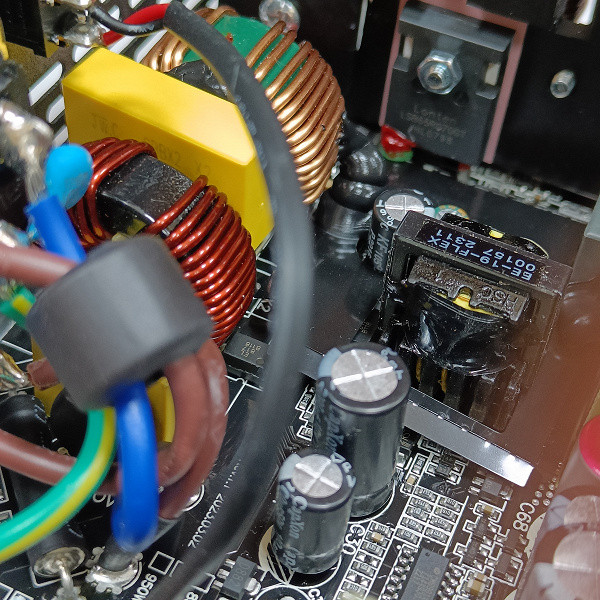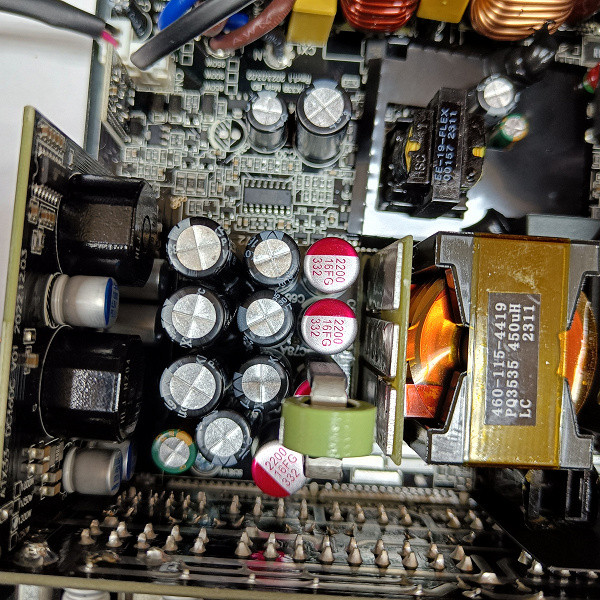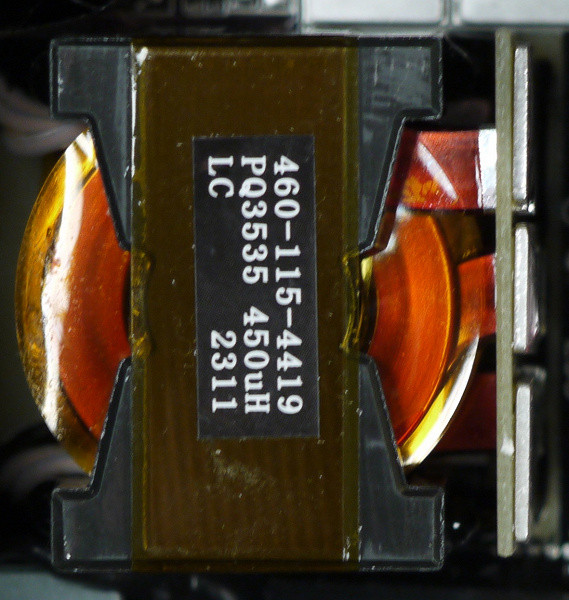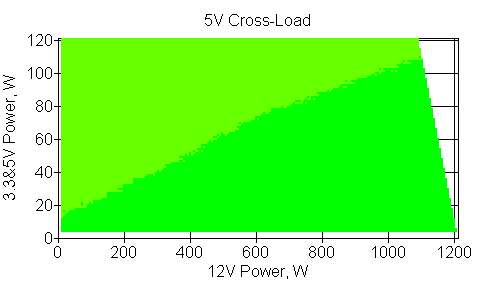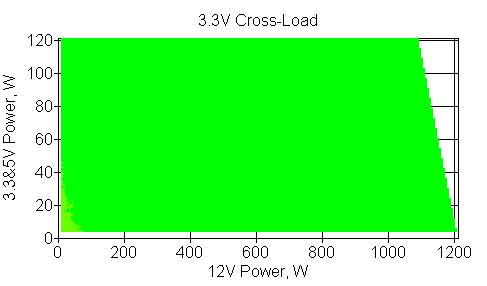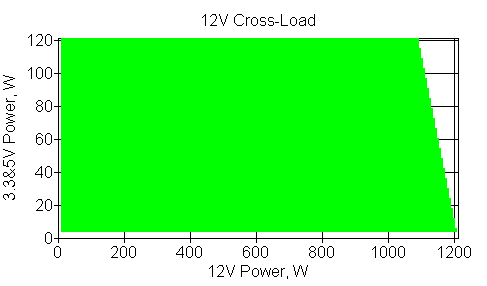High-wattage power supplies (1000 W or more) are often purchased for specific tasks, such as use in specialized test systems or for high-load computers intended for rendering, calculations and overclocking. Sometimes such power supplies are purchased simply to create power reserves for an existing system or with a future upgrade in mind. The market offers a wide range of such solutions, and choosing the right model can be a difficult task, given the differences in price and consumer characteristics.
Today we will look at one such product from Thermaltake: Toughpower GF A3 Gold 1200W. This power supply is 80Plus Gold certified, indicating high energy efficiency. Despite its enormous power, more than a kilowatt, this power supply can be classified in the middle price segment. At the time of writing this review, its cost in Russian stores started from 18 thousand rubles.
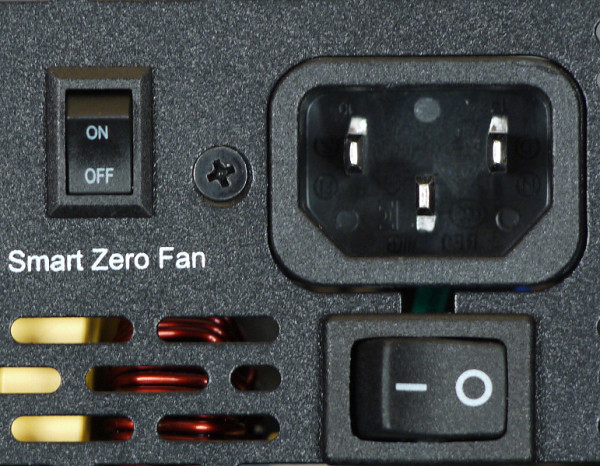
High-wattage power supplies (1000 W or more) are often purchased for specific tasks, such as use in specialized test systems or for high-load computers intended for rendering, calculations and overclocking. Sometimes such power supplies are purchased simply to create power reserves for an existing system or with a future upgrade in mind. The market offers a wide range of such solutions, and choosing the right model can be a difficult task, given the differences in price and consumer characteristics.
Today we will look at one such product from Thermaltake: Toughpower GF A3 Gold 1200W. This power supply is 80Plus Gold certified, indicating high energy efficiency. Despite its enormous power, more than a kilowatt, this power supply can be classified in the middle price segment. At the time of writing this review, its cost in Russian stores started from 18 thousand rubles.
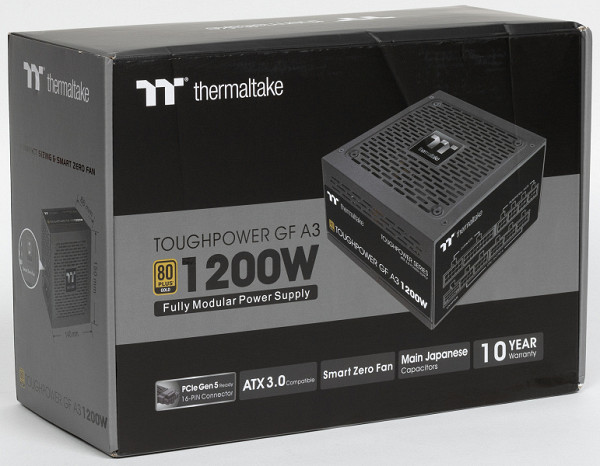
The packaging is made of durable cardboard with a matte finish and an illustration of the power supply on the front. The main colors of the design are black and grey.
Characteristics
All necessary information is indicated on the power supply housing. The +12VDC bus power is 1200W, which is 100% of the total power, which is an excellent result.

Wires and connectors
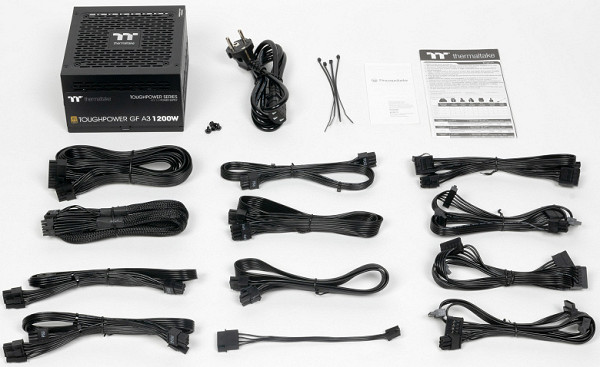
| Connector name | Number of connectors | Notes |
|---|---|---|
| 24 pin Main Power Connector | 1 | collapsible |
| 4 pin 12V Power Connector | — | |
| 8 pin SSI Processor Connector | 2 | collapsible |
| 6 pin PCIe 1.0 VGA Power Connector | — | |
| 8 pin PCIe 2.0 VGA Power Connector | 5 | on 3 cords |
| 16 pin PCIe 5.0 VGA Power Connector | 1 | |
| 4 pin Peripheral Connector | 4 | |
| 15 pin Serial ATA Connector | 12 | on 3 cords |
| 4 pin Floppy Drive Connector | 1 | adapter |
Length of wires to power connectors
Without exception, all wires are modular, that is, they can be removed, leaving only those that are necessary for a particular system.
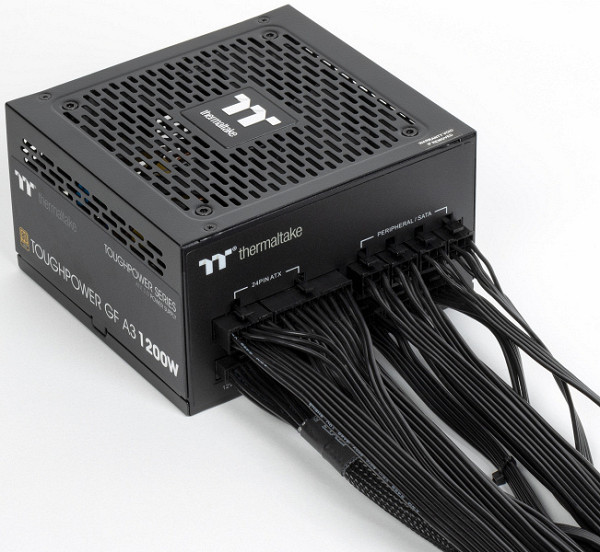
The length of the wires is quite sufficient for convenient use in full tower and larger cases with a top-mounted power supply. Even in cases up to 55 cm high with a bottom-mounted power supply, the length of the wires should be sufficient, especially to the processor power connectors — 65 cm each. It is possible to connect all four cords with PCIe 2.0 connectors, but only if only one of the two cords with processor power connectors is connected. Some sets of modern power supplies include a convenient adapter cord from a PCIe 5.0 connector to two PCIe 2.0 connectors or vice versa, allowing you to choose which connectors to use for connecting video cards. In this case there is no such choice. All SATA Power connectors are angled, which is not always convenient for connecting drives placed on the back of the motherboard base. The most convenient are cords with 1-2 power connectors with a straight plug for connecting devices in places with difficult access. Using ribbon wires up to the 12VHPWR connector simplifies the operation of the power supply because they are less susceptible to dust accumulation than standard nylon braided cords.
Circuit design and cooling
The power supply is equipped with an active power factor correction and has a wide input voltage range from 100 to 240 volts. This ensures stable operation even when the voltage in the electrical network is below normal.
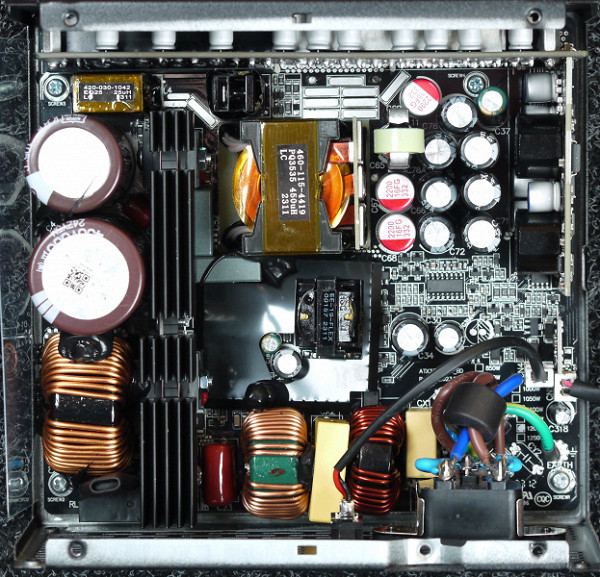
The design of the power supply corresponds to modern trends: it includes an active power factor corrector, a synchronous rectifier for the +12VDC channel and independent pulse-DC converters for the +3.3VDC and +5VDC lines.
Semiconductor elements of high-voltage circuits, including the input rectifier, are concentrated on one radiator. The synchronous rectifier is located on the reverse side of the main printed circuit board.

The daughter printed circuit board contains independent sources of +3.3VDC and 5VDC, characterized by the absence of additional heat sinks — this is typical for power supplies with active cooling.
The power supply uses high-quality high-voltage capacitors from Nippon Chemi-Con. Low-voltage capacitors are represented by products under the Capxon brand. In addition, the device contains a significant number of polymer capacitors.
The power supply uses a fan model HA1225H12F-Z (2200 rpm), equipped with a hydrodynamic bearing, which ensures long service life. This fan is manufactured by Dongguan Honghua Electronic Technology. The connection is made via a two-wire connector.
Electrical Characteristics Measurement
Next, we move on to an instrumental study of the electrical characteristics of the power source using a multifunctional stand and other equipment.
The deviation of the output voltages from the nominal value is color coded as follows:

Operating at maximum power
The first stage of testing is to operate the power supply at maximum power for a long time. Such a test allows you to confidently verify the functionality of the power supply.
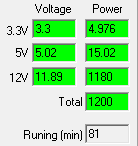
Cross-load characteristic
Next, testing involves constructing a cross-load characteristic (CLC) and displaying it on a quarter-plane. The ordinate and abscissa axes are limited to the maximum bus power of 3.3&5 V and 12 V, respectively. At each point on the graph, the voltage value is marked, the deviation from the nominal value is indicated by a color marker.
Analysis of the cross-load characteristic (CLC) allows you to determine the load level at which the voltage values remain within acceptable deviations. In this case, deviations from the nominal voltage values on the +12VDC channel do not exceed 1% at any load, which is an excellent indicator. With a typical power distribution across channels, deviations from the nominal also do not exceed 1% for the +3.3VDC channel, 1% for the +5VDC channel and 1% for the +12VDC channel.
This power supply is suitable for modern high-power systems due to the high load capacity of the +12VDC channel.
Load capacity
The purpose of the following test is to determine the maximum power that can be supplied through the appropriate connectors when the voltage tolerance is 3 percent or 5 percent of the nominal voltage.

In the case of a video card with a single power connector, the maximum power over the +12VDC channel is at least 150 W with a deviation within 3%.

In the case of a video card with a single power connector, the maximum power over the +12VDC channel is at least 150 W with a deviation within 3%.

In the case of a video card with two power connectors, when using two power cords, the maximum power over the +12VDC channel is at least 350 W with a deviation within 3%, which allows the use of very powerful video cards.

When loaded through three PCIe 2.0 connectors, the maximum power over the +12VDC channel is at least 640 W with a deviation within 3%.

When loaded through the processor power connector, the maximum power via the +12VDC channel is at least 230 W with a deviation within 3%. This is quite enough for typical systems that have only one connector on the motherboard for powering the processor.

When loaded through two processor power connectors, the maximum power via the +12VDC channel is about 500 W with a deviation within 3%.

In the case of a motherboard, the maximum power over the +12VDC channel is at least 150 W with a deviation of 3%. Since the board itself consumes within 10 W on this channel, high power may be required to power expansion cards — for example, for video cards without an additional power connector, which usually have a consumption within 75 W (however, it is unlikely that anyone will use them use with this power supply).
Cost-effective and efficient
When assessing the efficiency of a computer power supply, we can choose from two approaches. The first approach is to evaluate the power supply as a standalone electrical energy converter, followed by an attempt to minimize the resistance of the power transmission line from the power supply to the load. To do this, the power supply is usually connected using all available connectors, which creates unequal conditions for different power supplies due to different sets of connectors and the number of wires. However, this approach turns out to be of little use in real conditions, where the power supply is connected to a limited number of connectors, and not all at the same time. Therefore, it seems more logical to determine the efficiency of a power supply not only at fixed power values, but also taking into account a fixed set of connectors for each power value.
The second approach is to represent the efficiency of the power supply in the form of an efficiency value (coefficient of performance). Efficiency is determined by the ratio of the output and input powers of the power supply, which shows the efficiency of electrical energy conversion. However, this parameter may not be clear to the average user, although higher efficiency usually indicates a higher efficiency of the power supply. However, efficiency does not have a noticeable effect on the functioning of the system unit and is often used for marketing purposes.
Sometimes it is useful to estimate the efficiency of a power supply using absolute power consumption and power dissipation values. This allows you to evaluate the real difference in energy consumption between different models of power supplies and calculate the economic benefits of choosing a specific model. To do this, the power dissipation (the difference between the values at the input and output of the power supply), as well as the energy consumption of the power supply over a certain period of time when operating with a constant load, is calculated.
Thus, the efficiency of the power supply can be assessed taking into account power dissipation and electricity consumption, which allows us to draw conclusions about the economic feasibility of choosing a specific model.
| Load through connectors | 12VDC, W | 5VDC, W | 3.3VDC, W | Total power, W |
|---|---|---|---|---|
| main ATX, processor (12 V), SATA | 5 | 5 | 5 | 15 |
| main ATX, processor (12 V), SATA | 80 | 15 | 5 | 100 |
| main ATX, processor (12 V), SATA | 180 | 15 | 5 | 200 |
| Main ATX, CPU (12V), 6-pin PCIe, SATA | 380 | 15 | 5 | 400 |
| Main ATX, CPU (12V), 6-pin PCIe (1 cord with 2 connectors), SATA | 480 | 15 | 5 | 500 |
| main ATX, processor (12 V), 6-pin PCIe (2 cords per 1 connector), SATA | 480 | 15 | 5 | 500 |
| Main ATX, CPU (12 V), 6-pin PCIe (2 cords x 2 connectors), SATA | 730 | 15 | 5 | 750 |
The results obtained look like this:
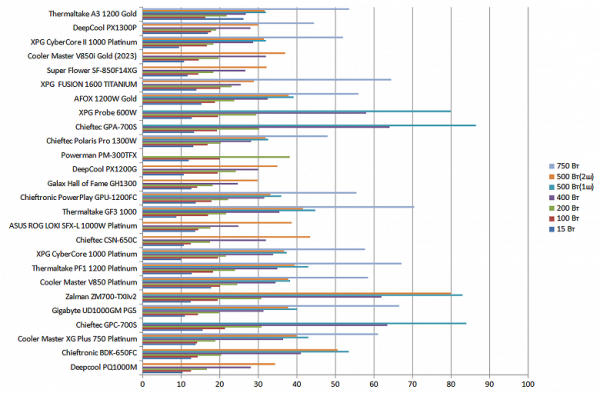
| Power dissipation, W | 15 W | 100 W | 200 W | 400 W | 500 W (1 cord) | 500 W (2 cords) | 750 W |
|---|---|---|---|---|---|---|---|
| Cooler Master V1000 Platinum (2020) | 19.8 | 21.0 | 25.5 | 38.0 | 43.5 | 41.0 | 55.3 |
| Thermaltake TF1 1550 | 13.8 | 15.1 | 17.0 | 24.2 | 30.0 | 42.0 | |
| Thermaltake GF1 1000 | 15.2 | 18.1 | 21.5 | 31.5 | 38.0 | 37.3 | 65.0 |
| Chieftec PPS-1050FC | 10.8 | 13.0 | 17.4 | 29.1 | 35.1 | 34.6 | 58.0 |
| Deepcool PQ1000M | 10.4 | 12.6 | 16.7 | 28.1 | 34.4 | ||
| Gigabyte UD1000GM PG5 | 11.0 | 14.4 | 19.9 | 31.4 | 40.1 | 37.8 | 66.6 |
| Thermaltake PF1 1200 Platinum | 12.8 | 18.3 | 24.0 | 35.0 | 43.0 | 39.5 | 67.2 |
| XPG CyberCore 1000 Platinum | 10.1 | 19.6 | 21.6 | 33.9 | 37.4 | 36.7 | 57.7 |
| Asus ROG Loki SFX-L 1000W Platinum | 13.7 | 14.5 | 17.6 | 24.9 | 38.7 | ||
| Thermaltake GF3 1000 | 8.8 | 17.0 | 21.7 | 35.5 | 44.8 | 41.6 | 70.5 |
| Chieftronic PowerPlay GPU-1200FC | 13.8 | 17.9 | 22.2 | 31.6 | 36.0 | 33.2 | 55.5 |
| Galax Hall of Fame GH1300 | 12.7 | 14.2 | 18.2 | 24.7 | 29.9 | ||
| Deepcool PX1200G | 10.7 | 19.5 | 24.2 | 30.0 | 35.0 | ||
| Chieftec Polaris Pro 1300W | 13.2 | 16.9 | 20.3 | 28.2 | 32.6 | 31.9 | 48.0 |
| Afox 1200W Gold | 15.3 | 18.8 | 23.8 | 32.5 | 39.2 | 37.9 | 56.0 |
| XPG Fusion 1600 Titanium | 14.0 | 20.2 | 23.1 | 25.5 | 28.9 | 64.5 | |
| XPG CyberCore II 1000 Platinum | 9.5 | 16.7 | 18.4 | 28.7 | 32.0 | 31.5 | 52.0 |
| DeepCool PX1300P | 17.0 | 17.8 | 19.1 | 28.0 | 30.0 | 44.5 | |
| Thermaltake GF A3 Gold 1200W | 26.2 | 16.3 | 21.8 | 26.8 | 32.0 | 31.7 | 53.6 |
| Formula VL-1000G5-MOD | 15.2 | 15.3 | 20.1 | 30.7 | 40.6 | 39.2 | 69.0 |
This model has relatively high efficiency in the higher tested modes, with increased power, but at low load this power supply, on the contrary, is one of the worst in its group. Here we must make a reservation that we included in the group only power sources with a power of more than a kilowatt, and when compared with conventional budget 300-watt power supplies, the result would be different.

In terms of overall efficiency at low and medium power, this model occupies the penultimate place in our list of power supplies with a power of 1 kW or more at the time of testing.
| Computer energy consumption per year, kWh | 15 W | 100 W | 200 W | 400 W | 500 W (1 cord) | 500 W (2 cords) | 750 W |
|---|---|---|---|---|---|---|---|
| Cooler Master V1000 Platinum (2020) | 305 | 1060 | 1975 | 3837 | 4761 | 4739 | 7054 |
| Thermaltake TF1 1550 | 252 | 1008 | 1901 | 3716 | 4643 | 6938 | |
| Thermaltake GF1 1000 | 265 | 1035 | 1940 | 3780 | 4713 | 4707 | 7139 |
| Chieftec PPS-1050FC | 226 | 990 | 1904 | 3759 | 4688 | 4683 | 7078 |
| Deepcool PQ1000M | 223 | 986 | 1898 | 3750 | 4681 | ||
| Gigabyte UD1000GM PG5 | 228 | 1002 | 1926 | 3779 | 4731 | 4711 | 7153 |
| Thermaltake PF1 1200 Platinum | 244 | 1036 | 1962 | 3811 | 4757 | 4726 | 7159 |
| XPG CyberCore 1000 Platinum | 220 | 1048 | 1941 | 3801 | 4708 | 4702 | 7076 |
| Asus ROG Loki SFX-L 1000W Platinum | 251 | 1003 | 1906 | 3722 | 4719 | ||
| Thermaltake GF3 1000 | 209 | 1025 | 1942 | 3815 | 4772 | 4744 | 7188 |
| Chieftronic PowerPlay GPU-1200FC | 252 | 1033 | 1947 | 3781 | 4695 | 4671 | 7056 |
| Galax Hall of Fame GH1300 | 243 | 1000 | 1911 | 3720 | 4642 | ||
| Deepcool PX1200G | 225 | 1047 | 1964 | 3767 | 4687 | ||
| Chieftec Polaris Pro 1300W | 247 | 1024 | 1930 | 3751 | 4666 | 4659 | 6991 |
| Afox 1200W Gold | 265 | 1041 | 1961 | 3789 | 4723 | 4712 | 7061 |
| XPG Fusion 1600 Titanium | 254 | 1053 | 1954 | 3727 | 4633 | 7135 | |
| XPG CyberCore II 1000 Platinum | 215 | 1022 | 1913 | 3755 | 4660 | 4656 | 7026 |
| DeepCool PX1300P | 280 | 1032 | 1919 | 3749 | 4643 | 6960 | |
| Thermaltake GF A3 Gold 1200W | 361 | 1019 | 1943 | 3739 | 4660 | 4658 | 7040 |
| Formula VL-1000G5-MOD | 265 | 1010 | 1928 | 3773 | 4736 | 4723 | 7174 |
In this case, we also provide measurements of traditional efficiency . The results were recorded at a constant load on the +3.3VDC (5 W) and +5VDC (15 W) channels and variable power on the +12VDC channel.
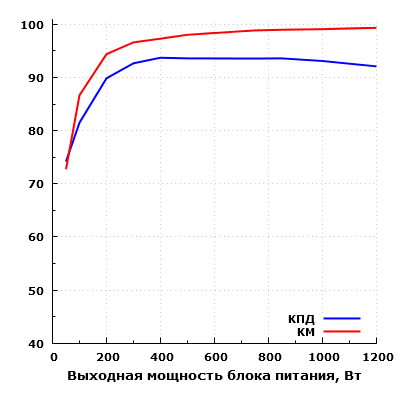
We measured the parameters of the power supply at 10 points. As a result, we obtained a maximum efficiency value of 93.7% with an output power of 400 W. The maximum power dissipation was 103 W with an output power of 1000 W, which is a small value for a power supply of this power.
Temperature
All main tests were carried out with the fan running continuously. In this mode, the thermal load on the capacitors remained low. However, at maximum power, the thermal load became quite high, but acceptable.
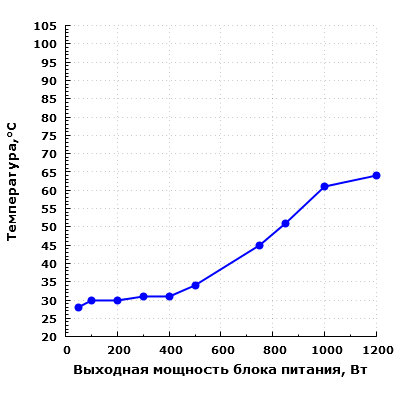
We also examined the operation of the power supply in hybrid cooling mode. As a result, it was noted that the fan turns on both when a certain temperature is reached (approximately 43 degrees), and when the output power reaches about 290 watts. The fan turns off only when the temperature drops to a certain level (approximately 38 degrees). However, these values are not always ideal: at power levels from 50 to 290 W, frequent fan cycles are observed, which negatively affects the noise of the device. The fan also produces noticeable noise during operation.
It should also be taken into account that when working with the fan turned off, the temperature of the internal components of the power supply is highly dependent on the ambient air temperature. When set to around 40-45 degrees Celsius, this may cause the fan to turn on earlier.
Acoustic ergonomics
When measuring the noise level of power supplies, we used the following methodology. The power supply was placed on a flat surface with a fan on top. At a distance of 0.35 meters from it, a measuring microphone of the Oktava 110A-Eco sound level meter was installed to measure the noise level. The load on the power supply was carried out using a special stand with a silent operating mode. The power supply was operated at constant power for 20 minutes, after which the noise level was measured.
This method allows you to evaluate the noise level of the power supply in conditions as close as possible to the desktop placement of the system unit with the power supply installed. Increasing the distance to the noise source and the presence of additional obstacles that reflect sound well also help reduce the noise level at the control point, which improves acoustic ergonomics in general.

When operating with a constantly rotating fan at a power of 50 to 1000 W, the noise level remains almost unchanged and is about 44 dBA at a distance of 0.35 meters. At maximum power it increases to 55 dBA.
This mode of operation is extremely rare in household power supplies and is most often the result of reworking powerful server power supplies. However, high noise levels, as in this case, create an uncomfortable environment when working with typical home and office computers. This noise level may only be acceptable under high load conditions, such as when playing games using headphones.
The noise level of the power supply electronics is assessed by measuring the difference between the noise levels with the power supply on and off. A difference of less than 5 dBA usually does not indicate defects, while a difference of more than 10 dBA may indicate certain problems. Measurements are taken at a distance of about 40 mm from the top plane of the power supply, which provides the most accurate results.
In standby mode, electronic noise is almost completely absent.
| Power, W | Noise level from the grille side, dBA | Deviation from background level, dBA |
|---|---|---|
| 0 | 28.5 | +8.5 |
| 15 | 24.0 | +4.0 |
| 100 | 26.8 | +6.8 |
| 200 | 21.7 | +1.7 |
There are no special complaints about the noise of the electronics, although it could be lower.
Consumer qualities
The consumer rating of Thermaltake Toughpower GF A3 Gold 1200W is reduced due to the high noise level in standard mode with a constantly rotating fan, as well as due to the unsuccessful implementation of the hybrid mode. In the latter, the noise remains approximately the same, and acoustic ergonomics suffer due to the constant start/stop cycles of the fan. These factors make the use of this power supply model impossible in rooms where noise is a problem, since working at a computer with such a noise source will be extremely inconvenient.
Results
From a technical point of view, Thermaltake Toughpower GF A3 Gold 1200W is a high-quality and expensive product. It is well suited for use on high-end systems, including those with multiple graphics cards. The technical characteristics of this model are at a high level thanks to the high load capacity of the +12VDC channel, high efficiency and a fan on a hydrodynamic bearing. You can expect a long service life from this model, even with heavy use and heavy loads. However, all these benefits from the end user's point of view are diminished by the constant high noise level, which is sometimes aggravated by constant stopping and starting of the fan.



